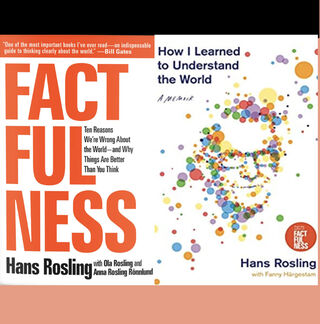Bias
10 Biases that Blind Us to a World Getting Better
Our pessimistic biases override the actual data
Posted December 21, 2021 Reviewed by Hara Estroff Marano
Key points
- The book Factfulness by Hans Rosling presents data suggesting dramatic improvements in the world over the last two centuries.
- Rosling is well-known for his colorful animated depictions of progress in world health and well-being.
- Rosling notes that most people are unaware of many improvements around the world.
- Rosling identifies 10 biases that keep us pessimistic about progress.
In 1800, 10 percent of the world’s population could read and write; today it’s 86 percent. Before 1893, women had the right to vote in zero countries; today women vote in 99 percent of the world. In 1800, 44 percent of children died before age 5; today it’s 4 percent.
In 1800, slavery was legal in most countries, and slaves were treated brutally by those exalted Greeks and Romans in the good old days of Western civilization. Today, slavery is illegal in almost every country in the world.

In Factfulness: Ten reasons we’re wrong about the world—and why things are better than you think, Hans Rosling presents a long list of things that have been steadily improving in the last two centuries, and another list of bad things getting better. To support his arguments, he presents some impressive data.
Maybe you’ve seen Rosling’s TED talks, he's the guy with the colorful moving bubbles showing all the world’s countries changing over time (those ingenious graphics were designed by his artistic and computer-savvy son Ola Rosling, who, along with daughter-in-law Anna Rosling Rönnlund, is coauthor of Factfulness). If you aren’t one of the 15,223,250 people who have watched Rosling’s brilliant 15-minute talk on The Best stats you’ve ever seen, I highly recommend it).
In the book, Rosling laments that even his brilliant students at Sweden’s prestigious Karolinska Institute (where they award the Nobel Prize in medicine) are woefully ignorant about the state of the world. Even faced with raw statistical facts, those super-smart young people continue to deny them. Like many people, his students were convinced that the world at large is getting worse in almost every way and couldn’t possibly be gradually getting better.
Why the pessimism?
Rosling was a global health physician, not a psychologist, but his list of references at the back of the book suggests he was trying to connect common misconceptions about global development with the literature from the field of psychology (Rosling’s book cites Robert Cialdini, Daniel Kahneman, Dan Ariely and Steven Pinker, for example.
Rosling advances his own list of 10 data-warping biases, including:
1. Exaggerating gaps. Rosling was highly concerned with the misperception that there are two widely separated groups of countries in the world—the West and the rest, or the developed and developing nations. This gap was real half a century ago, but as the TED talk shows, most countries are today clustered fairly closely to the developed end, with an increasingly small number of outliers fitting Western stereotypes of undeveloped nations. He notes that experts trying to convince you of a particular argument will often choose extreme examples rather than looking at the big cluster of cases in the middle.
2. Negativity bias. We are designed to notice threats, and the media feeds that attentional bias. So we are exposed to a lot of negative news every day (we never hear about the thousands of planes that land successfully, but if a plane crashes, it makes the headlines). Rosling thinks it’s not just the media to blame—they give us the news we want. But it’s not always good for us, and we ought to look at bad news in context.
3. Getting numbers out of perspective. Large numbers are impressive, but we need to ask what proportion of the total those big numbers represent. If I told you 3,140 Americans have been killed by animals over the last two decades, you might be hesitant to leave the safety of your car for a hike, for fear of being attacked by snakes, bears, mountain lions and scorpions. But it helps to realize that over 700,000 people died in automobile accidents during the same time. And for some real perspective, heart disease kills off 2,380 people every day (roughly 17,374,000 in a 20-year period, or 5,533 people for each person taken out by a non-human animal). So, better get outside for some exercise. Incidentally, I did something journalists often do, instead of telling you that 157 people are killed by animals annually (including bee stings and attacks by domestic animals), I gave you a 20-year total—to make it sound bigger!
4. Straight-line bias. We have a hard time with curvilinear relationships and tend to assume that whatever is trending now will continue. But sometimes the straight line is part of an S- or a U-shaped trend and won’t go on.
5. Fear bias. This connects with biases 2 and 3 above, and leads us to exaggerate the odds that we are in danger, especially if we are frightened.
6. Generalization bias. We tend to overemphasize differences and de-emphasize similarities between other groups and fail to differentiate between the members of other groups. Social psychologists call this out-group homogeneity. But "they" are not all the same.
7. Destiny bias. We tend to think that people in other countries are different in ways that are unchangeable. But Rosling notes that Sweden used to be extremely conservative, yet is now regarded as highly progressive. And women in Iran, who used to have double the fertility of Americans, have suddenly dropped to lower fertility rates than is the case in the U.S.
8. Single perspective bias. Our ideologies often lead us to see the world in oversimplified terms and to focus on one variable at a time. Cuba is very poor, for example, but compared to those living in wealthier democracies, its citizens are very healthy and well-educated.
9. The bias to blame others and not see our own faults. Here Rosling uses the example of Europeans and North Americans blaming China and India for world pollution when per-capita pollution is still vastly higher in Europe and North America.
10. The urgency bias! The media uses our fear and negativity biases to lead us to think that every social problem must be solved immediately or we’ll never be able to solve it in the future! This can lead to rash and simplistic solutions that are not fully tested against the data. We need to carefully consider which potential solutions will really help in the long run, and which ones will simply make us feel we are “doing something!!”
Rosling’s 10 biases overlap a bit, and I don’t always agree with his conclusions about how to interpret the data. For example, he seems comfortable allowing population to increase and economic development to be encouraged in countries that still have a long way to go. His rationale is that once people become economically comfortable and get access to health care so their children survive, they tend to voluntarily reduce family size. On that model, we can expect to see continuing decreases in fertility rates, but before the total numbers level off, we will see the world population go up to 10 or 11 billion. His arguments are thought-provoking, but we are pushing against the window of sustainability, and may have already broken it (yeah, I'm falling prey to the urgency bias here!)
Rosling’s take on the data showing a general trend toward progress is consistent with Steven Pinker’s analysis (10 ways the world is getting better). But Rosling isn’t a naïve optimist, noting that things can be improving yet also still bad. Poverty has decreased, but many still live miserably, without access to health care, for example.
Rosling also lists five global risks we should worry about:
1. Global pandemic
2. Financial collapse
3. World War III
5. Extreme poverty
Rosling died in 2017, before COVID, but first on his list is a global pandemic. In dealing with novel problems, though, Rosling would counsel us to look at hard data (see also How to overcome the 3 major sources of antiscientific thinking).
Rosling’s accompanying personal memoir (see the references below) is worth reading alongside Factfulness.
References
Rosling, H., Rosling, O., Rosling-Runnlund, A. (2018). Factfulness: Ten reasons we're wrong about the world - and why things are better than you think. New York: Flatiron Books.
Rosling, H. (2017). How I learned to understand the world: A memoir. New York: Flatiron Books.




